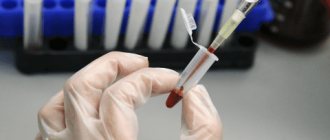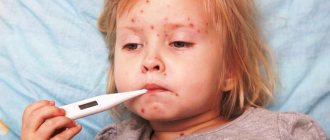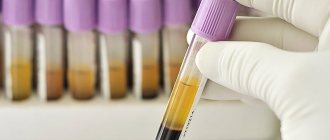Causes of measles
Measles is one of the most contagious diseases. The infection is transmitted by airborne droplets.
A person who is not immune to measles will almost certainly become ill when exposed to the infection, regardless of their age. In order to get sick, it is not necessary to have direct contact with a carrier of the infection; you can become infected, for example, by entering the room where he was recently located. There are known cases of the measles virus spreading over significant distances with air flow. But at the same time, the virus is not stable in the external environment; it quickly dies outside the human body from exposure to various chemical and physical factors (irradiation, boiling, treatment with disinfectants).
The incubation period of measles ranges from 7 to 14 days. The source of infection is a patient with measles in any form. The patient is contagious to others, starting from the last days of the incubation period (last 2 days) until the 4th day of the rash. From the 5th day of the rash, the patient is considered non-infectious.
Measles symptoms
The disease, if it develops in accordance with the typical picture, passes through three stages: catarrhal, the period of eruptions and the period of pigmentation.
In children under the age of one year, measles can occur in an erased form, since during this period the child has passive immunity received from the mother’s body.
Catarrhal stage
The onset of the disease is sudden, with symptoms reminiscent of a cold.
The temperature rises – up to 38-39°C. Headache, runny nose, conjunctivitis, dry and obsessive cough appear. Redness of the throat is observed, red spots appear on the hard and soft palate. The voice becomes hoarse. 1-2 days after the onset of the disease in the mouth, small whitish spots appear on the mucous membrane of the cheeks near the molars, surrounded by a narrow red border, slightly rising above the level of the mucous membrane. In appearance they resemble semolina or bran.
By the end of the first stage, the temperature decreases.
Period of rash
At the second stage (usually the 4th or 5th day of illness), the temperature rises again - up to 39-40 ° C and a rash appears: first on the face, neck, behind the ears. The next day - on the torso. On the 3rd day of the rash, the rash covers the extensor surfaces of the arms and legs, including the fingers. The rash has a dark red (purple) color, the elements of the rash merge. The affected skin becomes rough. The period of rash is the most severe stage of the disease.
On the fourth day after its appearance, the rash begins to fade away - in the same order as it appeared. The rash darkens, turns brown, becomes pigmented, peels off, and the temperature returns to normal.
Pigmentation period
Brown scaly spots at the site of the rash persist for another 1.5 weeks. This is the third stage of the disease - the period of pigmentation.
Measles
Measles is a highly contagious anthroponotic acute infectious disease with airborne transmission. The causative agent of measles is an RNA virus (family Paramyxoviridae, genus Morbillivirus). Only 1% of susceptible individuals do not become ill with measles upon first close contact with a sick person.
Measles begins with a prodromal period, which is characterized by an increase in body temperature to 38°C and above, cough, runny nose, sneezing, redness of the eyes and photophobia, enanthema in the oral cavity (Filatov-Koplik spots). From the 4th-5th day of illness, a gradual rash of maculopapular rash is observed (on the first day the rash appears on the face and neck, on the second day on the torso, on the third day on the legs and arms), pigmentation and pityriasis-like peeling remain at the site of the rash. The incubation period lasts on average about 10 days (from 7 to 18 days) from the moment of infection of the respiratory tract until the temperature rises.
Despite the availability of highly immunogenic vaccines, measles is still a leading cause of childhood mortality in developing countries and periodically leads to large outbreaks in industrialized countries. In 2010-2011, large outbreaks of measles were registered in a number of countries in Africa, Southeast Asia and Europe (France, Germany, Bulgaria, Romania). A particularly alarming situation arose in 2012 in Ukraine, where more than 10,000 people fell ill in three months. In the Russian Federation, most of whose administrative territories were certified free of endemic measles in January 2011, the situation became more complicated in 2011-2012 in the Southern and North Caucasus Federal Districts, Moscow, St. Petersburg and a number of other cities.
The measles virus is present in the blood, nasopharyngeal secretions and urine during the prodromal period and for 3-4 days from the onset of the rash. Antibodies to the measles virus can be detected in the blood for the first time since the onset of the rash. The maximum level of IgM antibodies in the blood occurs 4-7 days after the onset of the rash; they persist for 28 days; in rare cases, they can be detected 8 weeks after the onset of the rash. IgG antibodies begin to be produced from the moment the rash appears and reach their maximum level after 2 weeks; they can be detected for many years after the infection.
Indications for examination.
Patients diagnosed with measles, “measles?” and with other clinical diagnoses, having a maculopapular rash and a body temperature of 37.5°C or higher.
Differential diagnosis.
Diseases occurring with small-spotted exanthema (rubella, scarlet fever, infectious mononucleosis, drug and allergic exanthema occurring with an increase in body temperature).
Etiological laboratory diagnosis includes
isolation of measles virus, detection of measles virus RNA, detection of antibodies to measles virus.
Material for research
- Blood serum – detection of AT;
- urine, nasopharyngeal lavage, peripheral blood lymphocytes – isolation of measles virus;
- swabs from the nasopharynx and oropharynx - detection of virus RNA.
Comparative characteristics of laboratory diagnostic methods.
Laboratory diagnosis of measles infection within the framework of the Measles Elimination Program in the Russian Federation is carried out only in the virology laboratories of the Regional Centers for Epidemiological Surveillance of Measles using test systems recommended by WHO. For laboratory diagnosis of measles, detection of antibodies to the virus is mainly used (serological diagnosis). To diagnose measles, both the detection of antibodies of individual classes (IgM and IgG) and the quantitative determination of specific antibodies in the blood are used to establish their significant increase during the simultaneous examination of two samples obtained from a patient in the acute period and during the period of convalescence (paired sera).
To detect virus-specific IgM and IgG antibodies, the ELISA method is currently used predominantly. Thanks to high sensitivity and specificity, simplicity and speed of execution, and the ability to automate the study, the method is available to any laboratory. To obtain correct results and facilitate their interpretation, the correct timing of sample collection in relation to the appearance of clinical symptoms of measles is of great importance.
To detect changes in the level of total antibodies using the neutralization reaction (RN) of the cytopathic effect of the measles virus, two samples of blood serum taken from the patient in the acute period of the disease and at the stage of convalescence are required. The method has 100% sensitivity in relation to clinically confirmed cases. This test is not easy to perform because it requires highly trained personnel experienced in cell culture. Test results can be obtained 10 days after receiving convalescent serum.
Assessing changes in the content of specific antibodies using the RTGA method also requires the presence of two blood serum samples obtained from the patient in the acute period and at the convalescence stage. In vaccinated individuals, the method demonstrates 98% sensitivity. This test is also not easy to perform because it requires highly trained personnel and the availability of fresh monkey red blood cells. Test results can be obtained 2 days after receiving convalescent serum.
Measles virus isolation is performed on Vero cell culture. Detection and identification of the measles virus on cell culture can take several weeks, so it is not recommended to use this method for the primary diagnosis of infection; isolation of the measles virus is carried out in specialized laboratories.
Detection of viral RNA by reverse transcription PCR has not yet become widespread. Measles virus genome sequencing is used to determine the genotype of the measles pathogen. Genetic analysis makes it possible to compare strains obtained from different places in different years, which provides information about the origin of viruses and traces their routes of transmission.
Indications for the use of various laboratory tests.
To diagnose measles, WHO recommends using the detection of virus-specific IgM by ELISA in a blood serum sample taken after the fourth day from the onset of the rash. Blood is taken for research on days 4-7 from the moment the rash appears.
When IgM antibodies to the measles virus are detected in patients with fever and maculopapular rash examined as part of active epidemiological surveillance of measles, an additional study is carried out to detect IgG antibodies by ELISA in “paired sera.” Blood is taken for research on days 4-7 from the moment the rash appears (1st serum) and no earlier than 10-14 days from the date of taking the first sample (2nd serum).
To determine the strength of immunity to the measles virus, WHO recommends using the detection of IgG antibodies in blood serum by ELISA.
To identify the measles virus and its RNA, biomaterials taken during the prodromal period of the disease and in the first three days after the appearance of the rash are used. When collecting samples, it should be taken into account that the rate of virus excretion decreases rapidly.
Features of interpretation of laboratory research results.
Virus-specific IgM antibodies appear during the first days after the rash; after a month, their level begins to rapidly decrease. Their presence in the patient’s blood reliably indicates an acute, fresh infection. IgM Abs are also produced during primary vaccination and, although their level decreases more rapidly than the level of IgM Abs produced in response to infection with wild virus, specific IgM Abs to wild or vaccine virus cannot be separated by the methods used in routine diagnostics. In this case, the individual patient's vaccination history should be consulted to interpret the results.
Since the ELISA test for IgM antibodies has maximum sensitivity between 4 and 28 days from the onset of the rash, testing a blood sample obtained during these periods is considered adequate for diagnosing measles. A repeat blood sample may be necessary if the first blood sample obtained within the first three days of the onset of the rash is negative for IgM antibodies. Repeated blood sampling to detect IgG antibodies is performed 10-14 days after the first one. An increase in the titer of specific IgG antibodies by 4 or more times during simultaneous examination of both samples using standard tests is the basis for making a diagnosis of measles.
Methods for diagnosing measles
In most cases, measles is diagnosed based on examination of the patient. However, in some cases additional research is required.
General blood analysis
A general blood test is a basic test for any infectious disease. In case of measles, the analysis will show a decrease in the level of lymphocytes, leukocytes, monocytes, neutrophils and eosinophils (the latter may be completely absent). The erythrocyte sedimentation rate (ESR) increases moderately.
More information about the diagnostic method
General urine analysis
A general urine test - another "mandatory minimum" test - will show leukocyturia (increased white blood cell levels), as well as protein in the urine.
More information about the diagnostic method
Serological blood test
A serological blood test is designed to detect IgM and IgG antibodies to the measles virus. This analysis allows us to establish that the body was attacked by this particular virus. IgG antibodies provide immunity to this disease, preventing you from getting measles again. They begin to be produced from the second day of the rash (or 10-14 days from the onset of the disease).
More information about the diagnostic method
Chest X-ray
A chest x-ray is done to look for pneumonia, a possible complication of measles.
More information about the diagnostic method
Sign up for diagnostics To accurately diagnose the disease, make an appointment with specialists from the Family Doctor network.
Blood test for measles antibodies: how to prepare?
As we have already said, this analysis is necessary for making a diagnosis or assessing post-vaccination immunity. A referral for testing is issued by a therapist, infectious disease specialist or pediatrician. The patient can also get tested without a referral in any private laboratory. Venous blood is required for analysis. Before going to the laboratory, follow these rules: - the day before, exclude fatty foods and alcohol from your diet; — do not smoke before submitting biomaterial; - Do not eat breakfast before donating blood. At least 8 hours must pass before donating blood and the last meal, so it is better to limit yourself to a light dinner on the eve of the test; — intense physical activity before donating blood is also contraindicated; — if possible, stop taking medications on the eve of the study, and if this is not possible, inform your doctor and laboratory assistant about this when collecting biomaterial.
How to decipher the result of an IgG test
With this blood test, the concept of “normal” is incorrect, since the result can be either positive (antibodies are present) or negative (antibodies are not detected). Both cannot be assessed by the criteria of “healthy/unhealthy” or “good/bad”.
Negative (less than 0.80) - there is no immunoglobulin in the body or its concentration is minimal (depending on the laboratory, the range of values does not exceed 0.8-0.12 IU/ml). There is no immunity to measles. This means that the person has never had measles and is not vaccinated. It is worth consulting with your doctor about the need for vaccination. Positive (from 1, 20 or more) - antibodies have been detected, the person has immune protection. This means that the person has either had measles or been vaccinated. In rare cases, a false positive result is possible in some diseases (autoimmune diseases, chronic hepatitis). An important point is that a positive response can also be positive in case of measles, but the concentration of antibodies in this case should increase. Also, the IgM test must be positive. Ideally, these two analyzes should be done in combination. Doubtful (0.9-1.0 IU/ml) - in this case, the indicator slightly exceeds the minimum limit. It is recommended to repeat the study after 7-14 days.
How to decipher the result of an IgM analysis
This analysis is needed to clarify the diagnosis. There are two possible options: negative, positive or doubtful. Negative - the person does not have measles. There is no immunity to the virus. The result can also be negative if the analysis is carried out too early and antibodies have not had time to accumulate in the body. Positive indicates an acute period of the disease. Also, these proteins can be present in the body of a person who has recovered from the disease for 3 months after recovery, but gradually disappear from the body. Doubtful - the study is recommended to be repeated after 7-14 days.
An antibody test for Measles virus IgG (quantitative) can also be taken at the ELISA Medical Center. You can learn more about the study and find out the cost by following the link
However, remember that in order to avoid errors in deciphering the result, contact a general practitioner or infectious disease specialist.
what>
Treatment methods for measles
Treatment for measles is aimed at preventing complications, which are very likely. Measles can lead to inflammation of the middle ear (otitis), diseases of the throat and bronchi, pneumonia, and inflammation of the lymph nodes. Possible complications include blindness and encephalitis.
Non-drug treatment
A person with measles needs bed rest while the temperature persists. The room where the patient is located must be well ventilated. Twice a day, wet cleaning should be done there. If the light bothers the patient, the windows should be kept curtained.
Measles nutrition should be light, not irritating to the intestines, but at the same time high in calories. The patient must receive vitamins A and C.
Drug therapy
Drug treatment for measles may include antihistamines, antipyretics, vitamins, symptomatic drugs (eye drops, sputum thinners, etc.). If a bacterial infection occurs, antibiotics may be prescribed.
Vaccination
In the case of measles, we have clear confirmation of the well-known position that it is better to prevent a disease than to treat it. That is why vaccination against measles is included in the National and regional calendars of preventive vaccinations. Vaccination against measles is carried out at the age of 12 months. Immunity gained through vaccination is lost over time. Therefore, at the age of 6 years, revaccination is necessary. Primary and repeated immunization against measles is allowed up to the age of 35 years.
By contacting “Family Doctor” for measles vaccination, you guarantee that the vaccine will be of high quality and the medical staff will be highly qualified. Referrals for vaccination are issued by a pediatrician for children and a general practitioner for adults.
More information about the treatment method
Make an appointment Do not self-medicate. Contact our specialists who will correctly diagnose and prescribe treatment.
Rate how useful the material was
thank you for rating







